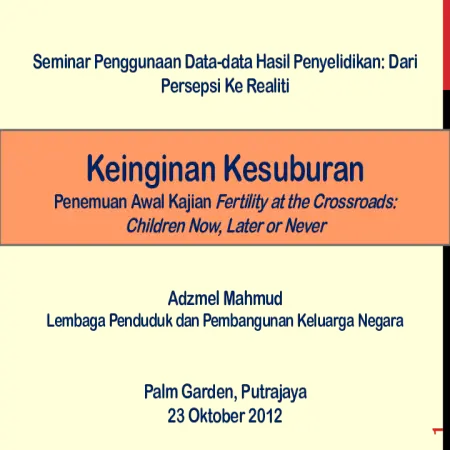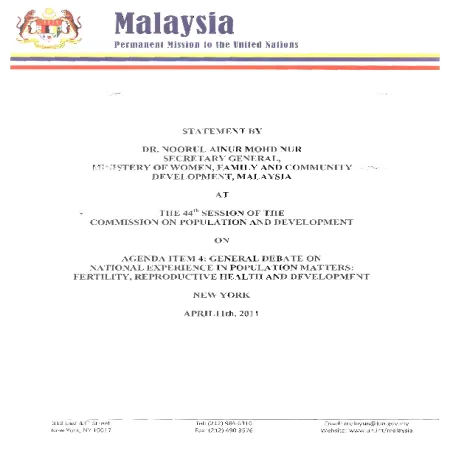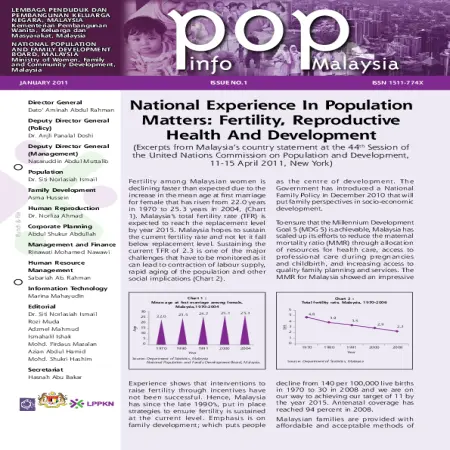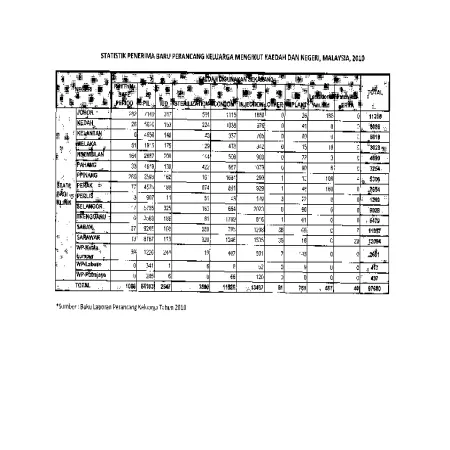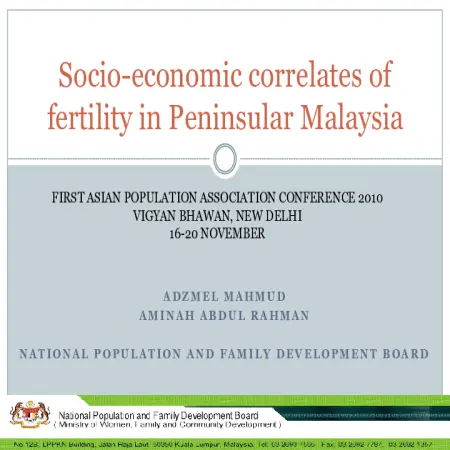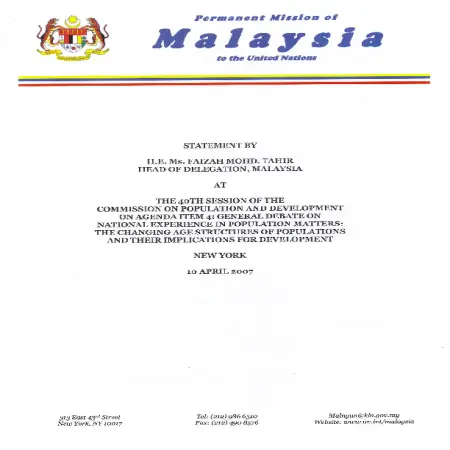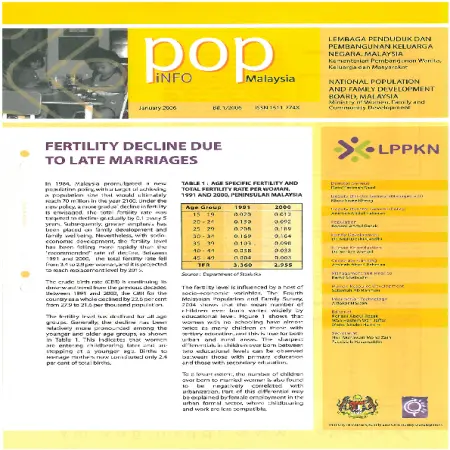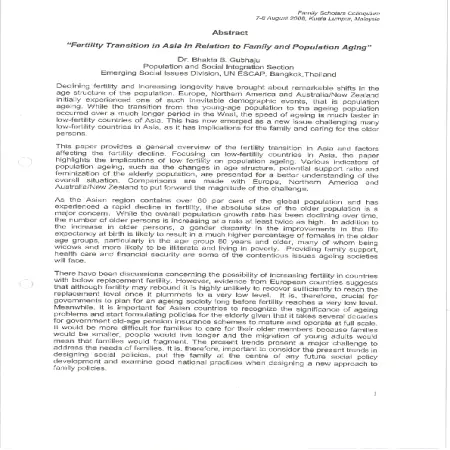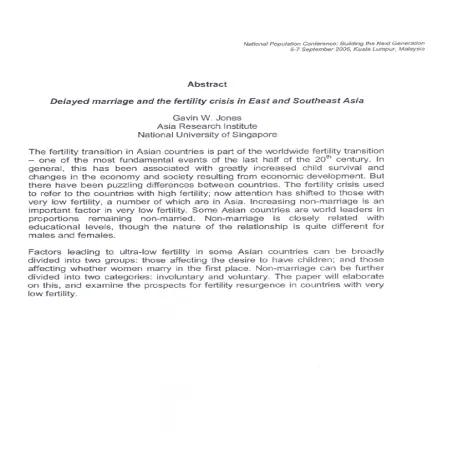TOPICS
Results for Topics : "Fertility"
|
|
Keinginan kesuburan
Item Type: Conference or Workshop Item
Editor:
Year: 00/00/2012
Abstract: The decline in fertility rates in Malaysia is happening rapidly and it is expected that the rate will reach the replacement level (replacement level = 2.1) in 2015. A woman's desire/decision to have a child has a direct impact on the fertility rate and population growth. Thus, the study aims to identify the factors that influence women's desire to have children or do not need to be implemented. Data and Methodology: This paper presents the preliminary findings of the study Fertility at the Crossroad: Children Now, Later or Never conducted by LPPKN in 2012. This study uses a cross -sectional survey design method with a focus on women in the reproductive age group. 15-49 years working in the public sector in Kuala Lumpur, Putrajaya and Selangor. The method of data collection was through face -to -face interviews and self -administered using a questionnaire. Through stratified sampling method, a total of 98 public sector agencies were selected. To achieve the objectives of the study, the data obtained were analyzed using Descriptive Statistics, Chi Square and Logistic Regression (Forward LR Method). The dependent variable studied was the desire to have children (0 = do not want more children, 1 = want more children). While there are nine (9) independent variables studied namely age, ethnicity, education level, job grade (Management and Professional/Support), income, number of childbirths, pregnancy history (miscarriage/stillbirth/abortion), fertility problems and The husband lives far away. Findings: In total, a total of 1,898 data for women working in the public sector were analyzed. A total of 75.9% of respondents have a desire to have children. The results of Chi -Square analysis showed that the variables of age, ethnicity, income, number of births, pregnancy history, fertility problems and husbands living far apart had a significant relationship with the desire to have children. However, there is no evidence to suggest that post grade has a relationship with childbearing desire. Logistic regression test (Forward LR Method) showed that 57.8% of the variation in women's desire to have children can be explained by four independent variables, namely fertility problems, ethnicity, age and number of births. Conclusion: The results of the study found that women's desire to have children can be considered high. To support women's desire to have children, various forms of assistance/support should be provided by the employer/government. Among the main assistance/support needed are childcare centers at work, holiday facilities to care for sick children, subsidized childcare costs and full-paid facilities for children in need of special care.
|
|
|
|
|
|
Fertility and religion in Malaysia
Item Type: Conference or Workshop Item
Editor:
Year: 00/00/2012
Abstract: This paper presents a summary of literature review on the subject of religious fertility differential for a research at the Institute of Graduate Studies, University of Malaya and initial results from investigations using the MPFS 41 (Peninsular Malaysia) data. Conceptual frameworks due to Davis and Blake (1956) and Bongaarts (1978) are used to construct a framework of data analysis using SPSS, concentrating on one-way ANOVA and Stepwise Multiple Regression. Next, the influence of religion on age-at-firt-marriage is compared to that of education level, pre-marital working experience and place of residence. Similar to studies done elsewhere, Muslims in Peninsular Malaysia have the highest fertility level and the lowest age at first marriage.
|
|
|
|
|
|
The 44th session of the Commission on Population and Development on agenda item 4: general debate on national experience in population matters: fertility, reproductive health and development, 11th April, 2011
Item Type: Country Statement
Editor:
Year: 11/04/2011
Abstract: Fertility among Malaysian women is declining faster than expected due to the increase in the average age at first marriage for women that has risen from 24.7 years in 1991 to 25.3 in 2004. Malaysia's total fertility rate (TFR) is expected to reach the replacement level by year 2015. With more and more women participating in the labour force and prioritising career development, this has also led to many highly educated women choosing to marry late or not to marry at all.
Malaysia hopes to sustain the current fertility rate and not let it fall below replacement level. Sustaining the current TFR of 2.3 is one of the major challenges that has to be monitored as it can lead to contraction of labour supply, rapid aging of the population and other social implications.
|
|
|
|
|
|
National experience in population matters : fertility, reproductive health and development
Item Type: Newsletter
Editor:
Year: 00/01/2011
Abstract: Fertility among Malaysian women is declining faster than expected due to the increase in the mean age at first marriage for female that has risen from 22.0 years in 1970 to 25.3 years in 2004. Malaysia’s total fertility rate (TFR) is expected to reach the replacement level by year 2015. Malaysia hopes to sustain the current fertility rate and not let it fall below replacement level.
|
|
|
|
|
|
Socio-economic correlates of fertility in Peninsular Malaysia
Item Type: Conference or Workshop Item
Editor:
Year: 00/00/2010
Abstract: To examine fertility trends and differentials among women in Peninsular Malaysia by selected socioeconomic variables which significantly influence the number of children ever born. A total of 3,697 ever-married women aged 15-49 were successfully interviewed in Peninsular Malaysia.
|
|
|
|
|
|
The 40th session of the Commission on Population and Development on agenda item 4: general debate on national experience in population matters: the changing age structures of populations and their implications for development, New York, 10 April 2007
Item Type: Country Statement
Editor:
Year: 10/04/2007
Abstract: The transition from a regime of high mortality and high fertility to one of low mortality and low fertility in Malaysia is a relatively recent phenomenon. similar to the trends in many developing countries, the demographic transition in Malaysia is characterized by rapid declined in mortality and moderate declines in fertility. The crude death rate has drastically declines from a high of 20.0 in 1947 to a very low level of 4.5 deaths per thousand populations in 2006. Such a rapid declines was due to improvements in the health sectors and higher socio-economic development in the country.
|
|
|
|
|
|
Fertility decline due to late marriages
Item Type: Newsletter
Editor:
Year: 00/01/2006
Abstract: Rising education, delayed and non-marriage will become more prevalent. Marriage postponement shortens childbearing span, and it will result in further fertility decline. Changes in marital structure have significant implications on the family system and the care of older persons. With rising age at marriage and consequently delayed childbearing , many retirees are still supporting children who are studying in institutions of higher learning.
|
|
|
|
|
|
Fertility transition in Asia in relation to family and population aging
Item Type: Conference or Workshop Item
Editor:
Year: 00/00/2006
Abstract: Declining fertility and increasing longevity have brought about remarkable shifts in the age structure of the population. Europe, Northern America and Australia/New Zealand initially experienced one of such inevitable demographic events, that is population aging. While the transition from the young-age population to the aging population occurred over a much longer period in the West, the speed of aging is much faster in low-fertility countries of Asia. This has now emerged as a new issue challenging many low-fertility countries in Asia, as it has implications for the family and caring for the older persons. This paper provides a general overview of the fertility transition in Asia and factors affecting the fertility decline. Focusing on low-fertility countries in Asia, the paper highlights the implications of low fertility on population aging. Various indicators of population aging, such as the changes in age structure, potential support ratio and feminization of the elderly population, are presented for a better understanding of the overall situation. Comparisons are made with Europe, Northern America and Australia/New Zealand to put forward the magnitude of the challenge. As the Asian region contains over 60 percents of the global population and has experienced a rapid decline in fertility, the absolute size of the older population is a major concern. While the overall population growth rate has been declining over time, the number of older persons is increasing at a rate at least twice as high. In addition to the increase in older persons, a gender disparity in the improvements in the life expectancy at birth is likely to be illiterate and living in poverty. Providing family support, health care and financial security are some of the contentious issues aging societies will face. There have been discussions concerning the possibility of increasing fertility in countries with below replacement fertility. It is, therefore, crucial for governments to plan for an aging society long before fertility reaches a very low level. Meanwhile, it is important for Asian countries to recognize the significance of aging problems and start formulating policies for the elderly given that it takes several decades for government old-age pension insurance schemes to mature and operate at full scale. It would be more difficult for families to care for their older members because families would be smaller, people would live longer and the migration of young adults would mean that families would fragment. the present trends present a major challenge to address the needs of families. It is, therefore, important to consider the present trends in designing social policies, put the family at the centre of any future social policy development and examine good national practices when designing a new approach to family policies.
|
|
|
|
|
|
Delayed marriage and the fertility crisis in East and Southeast Asia
Item Type: Conference or Workshop Item
Editor:
Year: 00/00/2006
Abstract: The fertility transition in Asian Countries is part of the worldwide fertility transition and one of the most fundamental events of the last half of the 20th century. In general, this has been associated with greatly increased child survival and changes in the economy and society resulting from economic development. But there have been puzzling differences between countries. The fertility crisis used to refer to the countries with high fertility but now attention has shifted to those with very low fertility, a number of which are in Asia.
|
|
|
|





